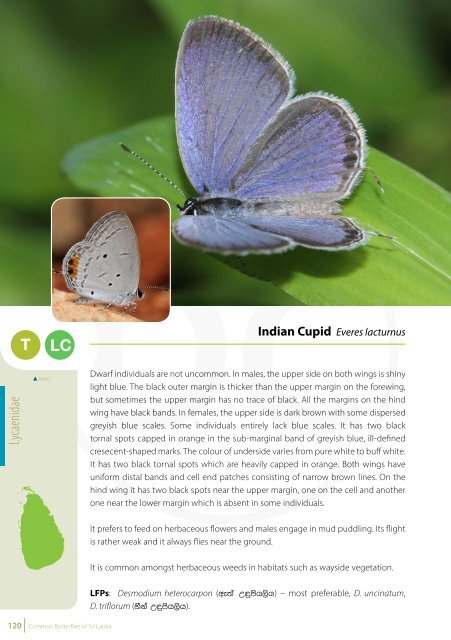Common Butterflies of Sri Lanka
Common Butterflies of Sri Lanka
Common Butterflies of Sri Lanka
You also want an ePaper? Increase the reach of your titles
YUMPU automatically turns print PDFs into web optimized ePapers that Google loves.
T<br />
LC<br />
Indian Cupid Everes lacturnus<br />
<strong>Common</strong> Hedge Blue Acytolepis puspa<br />
T<br />
LC<br />
Lycaenidae<br />
Male<br />
Dwarf individuals are not uncommon. In males, the upper side on both wings is shiny<br />
light blue. The black outer margin is thicker than the upper margin on the forewing,<br />
but sometimes the upper margin has no trace <strong>of</strong> black. All the margins on the hind<br />
wing have black bands. In females, the upper side is dark brown with some dispersed<br />
greyish blue scales. Some individuals entirely lack blue scales. It has two black<br />
tornal spots capped in orange in the sub-marginal band <strong>of</strong> greyish blue, ill-defined<br />
cresecent-shaped marks. The colour <strong>of</strong> underside varies from pure white to buff white.<br />
It has two black tornal spots which are heavily capped in orange. Both wings have<br />
uniform distal bands and cell end patches consisting <strong>of</strong> narrow brown lines. On the<br />
hind wing it has two black spots near the upper margin, one on the cell and another<br />
one near the lower margin which is absent in some individuals.<br />
It prefers to feed on herbaceous flowers and males engage in mud puddling. Its flight<br />
is rather weak and it always flies near the ground.<br />
It is common amongst herbaceous weeds in habitats such as wayside vegetation.<br />
In males, the upper side is shiny metallic blue with black marginal bands. It has a thin<br />
black outer margin on the hind wing. Both wings have varied white dustings on the<br />
centre. The female has broad marginal bands and the blue is restricted to the bases.<br />
Its basal area brighter, becoming whitish distally. The hind wing has a sub-marginal<br />
row <strong>of</strong> cresecent-shaped marks. The underside is similar in both sexes and the patches<br />
are usually larger than in other Hedge Blues. It has a sub-marginal row <strong>of</strong> distinct spots<br />
and an internal band <strong>of</strong> cresecent-shaped markings on both wings. The forewing<br />
has an irregular distal band consisting <strong>of</strong> thick brown lines and a cell end patch. The<br />
hind wing has many brown and black patches. It always has a small black spot at the<br />
intersection <strong>of</strong> 8th vein and cell vein which is located basally to large black spots.<br />
As the name implies, the <strong>Common</strong> Hedge Blue flies busily around hedges. It feeds on<br />
flowers and males engage in mud sipping. It is a migratory species.<br />
It prefers rather wet habitats such as forests and verdant gardens and it also appears<br />
in scrublands with sparse trees in the rainy season.<br />
Male<br />
Lycaenidae<br />
LFPs: Desmodium heterocarpon (we;a W÷msh,sh) – most preferable, D. uncinatum,<br />
D. triflorum (ySka W÷msh,sh).<br />
LFPs: Hiptage benghalensis (mqjla f.äh je,a), Bridelia retusa (leglE,), Schleichera<br />
oleosa (fldaka).<br />
120 <strong>Common</strong> <strong>Butterflies</strong> <strong>of</strong> <strong>Sri</strong> <strong>Lanka</strong><br />
<strong>Common</strong> <strong>Butterflies</strong> <strong>of</strong> <strong>Sri</strong> <strong>Lanka</strong> 121















